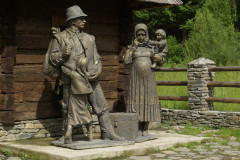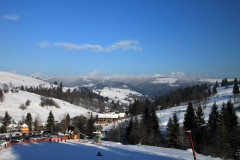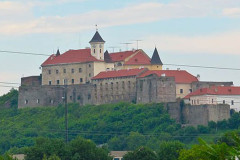Zakarpattia Region
Description
The Zakarpattia Oblast is an administrative oblast (province) located in southwestern Ukraine, coterminous with the historical region of Carpathian Ruthenia. Its administrative center is the city of Uzhhorod. Other major cities within the oblast include Mukachevo, Khust, Berehove and Chop which is home to railroad transport infrastructure.
Zakarpattia Oblast was established on 22 January 1946, after Czechoslovakia ceded the territory of Subcarpathian Rus to the Ukrainian Soviet Socialist Republic, under a treaty between Czechoslovakia and the Soviet Union. Some scholars say that during the Ukrainian independence referendum held in 1991, Zakarpattia Oblast voters were given a separate option on whether or not they favored autonomy for the region. Although a large majority favored autonomy, it was not granted. However, this referendum was about self-government status, not about autonomy (like in Crimea).
Situated in the Carpathian Mountains of western Ukraine, Zakarpattia Oblast is the only Ukrainian administrative division which borders upon four countries: Poland, Slovakia, Hungary, and Romania. The Carpathian Mountains play a major part in the oblast's economy, making the region an important tourist and travel destination housing many ski and spa resorts.
The oblast is ranked 23rd by area and 17th by population. According to the 2001 Ukrainian Census, the population of Zakarpattia Oblast is 1,254,614. This total includes people of many different nationalities of which Hungarians, Romanians and Rusyns constitute significant minorities in some of the province's cities, while in others, they form the majority of the population (as in the case of Berehove).
Name
The oblast is also referred to as the Transcarpathian Oblast, Transcarpathia, Zakarpattya, or historically as Subcarpathian Rus. In other languages the oblast is named:
- Rusyn: Подкарпатьска област, translit. Podkarpat’ska oblast.
- Hungarian: Kárpátalja
- Czech: Podkarpatská rus
- Slovak: Zakarpatská oblasť
- Polish: Obwód zakarpacki
- Romanian: Maramureșul de Nord or Regiunea Transcarpatia pronounced [red͡ʒiˈune̯a subkarˈpat͡i.a]
- Russian: Закарпатская область, translit. Zakarpatskaya oblast
While the name Transcarpathia is a translation of the Ukrainian version of the name, the Hungarian name translates as Subcarpathia, following the Hungarian language logic "feet of the mountains", naming a territory after its geographic location at the lower section of a mountain range. (Following the same language pattern that applies to the name of the sub-Alpian territory in Western Hungary, Alpokalja)
Generally, the Transcarpathia name and its versions reflect the East Slavic language logic, while some Western languages follow the same logic as the Hungarian:
- English: Subcarpathia, Subcarpathian Russia, Subcarpathian Ruthenia, Sub-Carpathian Ukraine
- French: Ukraine Subcarpathique, Russie subcarpathique
Other Western languages follow their own logic in creating a name for the region:
- German: Karpatenrussland, Karpatenland, Karpathenland, Karpatho-Russland, Karpatenukraine, Karpato-Ukraine
The coat of arms of Zakarpattia was originally created in the end of the 1910s in the then Czechoslovakia.
Geography
The Zakarpattia Oblast has a total area of 12,800 km2 (4,942 sq mi) and is located on southwestern slopes and foothills of the Carpathian Mountains covering around 80% of area in the region. The rest of the region is covered by the Transcarpathian Lowland which is part of the Pannonian plain. Zakarpattia is the only Ukrainian oblast to have boundaries with four countries: Poland, Slovakia, Hungary and Romania. On the West it borders the Prešov and Košice Regions of Slovakia and Borsod-Abaúj-Zemplén and Szabolcs-Szatmár-Bereg Counties of Hungary, on the South—the Satu Mare and Maramureş Counties of Romania, on the East and Northeast—Ivano-Frankivsk Oblast, and on the North—Lviv Oblast and the Subcarpathian Voivodeship of Poland.
The forest-covered mountainous landscape within the oblast.The Zakarpattia Oblast mostly consists of mountains and small hills covered with deciduous and coniferous forests, as well as alpine meadows. Mountains cover about 80% of the oblast's area, and cross from North-East to South-East. The Primeval Beech Forests of the Carpathians, part of which are located within Zakarpattia Oblast, were recognized as a UNESCO World Heritage Site in 2007.
The largest rivers that flow through the oblast include the Tysa, Borzhava, and the Tereblia. A high altitude lake is located in Rakhiv Raion, which is the highest in the region. It is called Nesamovyte. The lake is located in the Hoverla preserve on the slopes of Turkul mountain. The lake's area is 3,000 square metres (32,000 sq ft) and it is located 1,750 metres (5,740 ft) above sea level.
The region's climate is moderate and continental with about 700–1,000 mm (28–39 in) of rainfall per year. The average temperature in summer is +21 °С (70 °F) and −4 °С (25 °F) in winter. With a total height of 2,061 metres (6,762 ft), Hoverla, part of the Chornohora mountain range, is the tallest point in the oblast. The lowest point, 101 m (331 ft) above sea level, is located in the village of Ruski Heyevtsi (Oroszgejőc in Hungarian) in the Uzhhorodskyi Raion.
The four of the oblast's historical-cultural sites were nominated for the Seven Wonders of Ukraine competition in 2007: Palanok Castle, Museum upon the Chorna River, Mykhailiv Orthodox Church, and the Nevytsky Castle.
History
The lands of Transcarpathia for a long time were part of the Kingdom of Hungary, which became the Hungarian part of Austria-Hungary until the latter's demise at the end of World War I. It approximately consists of four Hungarian counties (comitatus): Bereg, Ung, Ugocsa, and Maramaros. This region was briefly part of the short-lived West Ukrainian National Republic in 1918. The region was annexed by Romania by the end of that year, mostly the eastern portion such as Rakhiv and Khust. It was later recaptured by Hungarian Soviet Republic in the summer of 1919. Finally, under the name Subcarpathian Rus (Czech: Podkarpatská Rus), after the Paris Peace Conference of 1919 it was annexed to Czechoslovakia with a supposedly equal level of autonomy as Slovakia and Bohemia-Moravia-Czech Silesia (Czech lands). Nevertheless, such autonomy was granted as late as in 1938, after detrimental events of the Munich Conference; until then this land was administered directly from Prague by the government-appointed provincial presidents (zemští prezidenti) and/or elected governors (guvernéři).
The province has a unique footnote in history as the only region in the former Czechoslovakia to have had an American governor: its first governor was Gregory Zatkovich, an American citizen who had earlier emigrated from the region and represented the Rusyn community in the U.S. Zatkovich was appointed governor by Czechoslovakia's first president, T. G. Masaryk in 1920, and served for about one year until he resigned over differences regarding the region's autonomy.
Zakarpattia (orange) as part of the territory claimed by the West Ukrainian People's Republic (1918)During the World War II German occupation of Czechoslovakia, the southern part of the region was awarded to Hungary under the First Vienna Award in 1938. The remaining portion was constituted as an autonomous region of the short-lived Second Czechoslovak Republic. After the occupation of Bohemia and Moravia on March 15, 1939 and the Slovak declaration of an independent state, Carpathian Ruthenia declared its independence as the Republic of Carpatho-Ukraine, but was immediately occupied and later annexed by Hungary.
During the German occupation of Hungary in 1944, almost the entire Jewish population was deported; few survived the Holocaust. In October 1944 the Sub-Carpathian Ukraine was occupied by the Red Army. In June 29, 1945, Czechoslovak President Edvard Beneš signed a treaty ceding the area and the next month it was united with the Ukrainian SSR through the "Manifest for unification with the Soviet Ukraine" that was accepted by the 1st Congress of People's Committees of Sub-Carpathian Ukraine without any knowledge of common people. It was then annexed into the Ukrainian SSR as Zakarpattia Oblast. After the break-up of the Soviet Union, it became part of independent Ukraine.
After the fall of the Soviet Union in 1991, Ukraine held an independence referendum in which the residents of Zakarpattia were asked about the Zakarpattia Oblast Council's proposal for self-rule. About 78% of the oblast's population voted in favor of autonomy; however, it was not granted. There were also propositions of separating from Ukraine to rejoin Czechoslovakia, but after Czechoslovakia's dissolution into the Czech Republic and the Slovak Republic (1993), these ideas have been rendered largely moot.
On October 25, 2008, delegates to the Congress of Carpathian Ruthenians declared the formation of the Republic of Carpathian Ruthenia. The prosecutor’s office of Zakarpattia region has filed a case against Russian Orthodox Church priest Dmytro Sidor and Yevhen Zhupan, an Our Ukraine party deputy of the Zakarpattia regional council and chairman of the People’s Council of Ruthenians, on charges of encroaching on the territorial integrity and inviolability of Ukraine.
Culture
Wooden churches
- Sredne Vodyane churches
- Verkhnye Vodyane church
- Danylovo church
- Kolodne church
- Krainykovo church
- Nyzhnie Selyshche church
- Olexandrivka church
- Sokyrnytsia church











